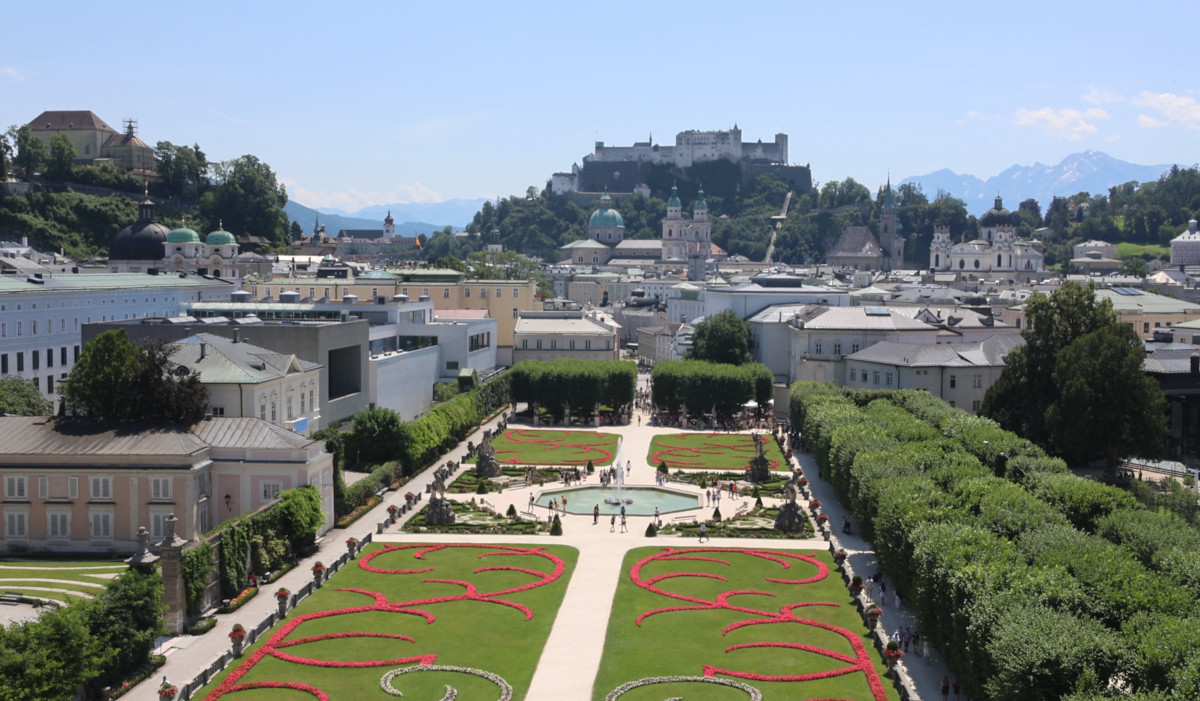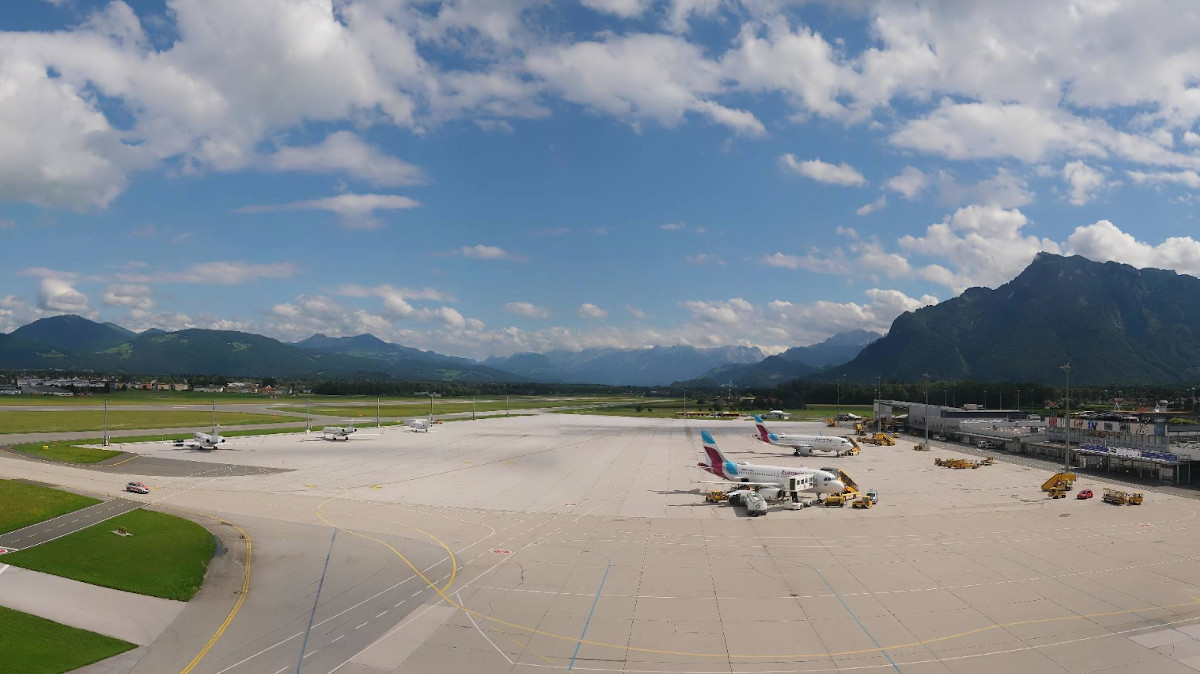Salzburg Live Webcams
Live webcams in Salzburg stream views of the streets, squares, churches, historic center, hotels, parks, waterfronts, and landmarks of the fourth-largest city in Austria. The webcams provide panoramic views of the city and allow you to check the current weather conditions in Salzburg from anywhere in the world. Some webcams even broadcast with sound. The popular streams are listed at the top of the webcam directory. An interactive map shows the precise location of each webcam throughout Salzburg.
Brief information about Salzburg
Salzburg (meaning “Salt Fortress”) is the fourth-largest city in Austria and the capital of the federal state of Salzburg. The city is famous for its well-preserved Baroque architecture, its Old Town — a UNESCO World Heritage Site — and for being the birthplace of the legendary composer Wolfgang Amadeus Mozart. As of January 2022, Salzburg has a population of 155,416 residents and covers an area of approximately 65.65 square kilometers (25.35 square miles).
Salzburg lies on the banks of the Salzach River in western Austria, at the northern edge of the Alps, at an elevation of 424 meters (1,391 feet) above sea level. It is located about 145 kilometers (90 miles) east of Munich, 300 kilometers (186 miles) west of Vienna, and just 5 kilometers (3 miles) from the German border.
Salzburg’s history spans thousands of years. The site was originally a Celtic settlement, later conquered by the Romans in the 1st century BCE. In 45 CE, the Roman colony of Iuvavum was established here. In 696 CE, the Bavarian Duke granted these lands to Bishop Rupert, who founded two monasteries that became the nucleus of the future city. In 798, Salzburg became an archbishopric. The Hohensalzburg Fortress, one of the largest and best-preserved medieval fortresses in Europe, was constructed in 1077.
Historically, Salzburg’s economy was based on salt mining and trade. Today, it is a highly developed industrial and post-industrial center specializing in automation, high-tech, software, and telecommunications industries. Tourism plays a vital role, with up to 7 million visitors arriving each year.
Salzburg boasts excellent transport infrastructure, with direct railway connections to Vienna, Munich, Innsbruck, and Zurich. Salzburg Airport offers regular flights to major European cities. Within the city, there is an extensive trolleybus and bus network, along with four suburban S-Bahn railway lines. The Old Town and the Hohensalzburg Fortress are connected by a funicular railway.
Climate in Salzburg
Salzburg has a temperate continental climate influenced by Alpine air masses. The climate features mild winters and warm summers, with fairly consistent rainfall throughout the year.
Winter temperatures are moderately cold, while summers are warm and humid. The average temperature in July, the warmest month, is about +19°C (66°F), while the average in January is around -1°C (30°F).
Salzburg receives a substantial amount of precipitation, with an annual average of around 1,180 millimeters (46.5 inches). The wettest months are typically June and July. Snowfall is possible during winter, but a stable snow cover is rare in the city.
The best time to visit Salzburg is from May to September when the weather is most favorable for sightseeing and outdoor activities. In winter, Salzburg attracts visitors with its festive Christmas markets and nearby winter sports resorts.
Top Attractions in Salzburg
Salzburg is renowned for its historical and cultural landmarks, many located in the UNESCO-listed Old Town.
— Hohensalzburg Fortress (Festung Hohensalzburg): The iconic symbol of Salzburg, one of the largest and best-preserved medieval fortresses in Central Europe. It was built in 1077 by Archbishop Gebhard as both a defensive stronghold and a residence during turbulent times. Perched atop Festungsberg Hill, it offers sweeping panoramic views of the city and the surrounding landscape.
— Salzburg Cathedral (Salzburger Dom): A masterpiece of Baroque architecture and the spiritual heart of Salzburg. The first church on this site was built in 774, but the current cathedral dates from the 17th century (completed in 1628). Wolfgang Amadeus Mozart was baptized here. The cathedral’s white marble façade and richly decorated interiors, featuring stunning frescoes and a magnificent organ, are truly impressive.
— Mozart’s Birthplace (Mozarts Geburtshaus): The house where Wolfgang Amadeus Mozart was born in 1756, located at No. 9 Getreidegasse. The museum showcases Mozart’s life and work, including personal items, musical instruments, and original manuscripts. It is one of the most visited attractions in Austria.
— Archbishop’s Residence (Residenz Salzburg): A lavish palace in the heart of the Old Town that served as the official residence of Salzburg’s ruling archbishops. Built beginning in the late 16th century, the palace boasts splendid Renaissance and Baroque-style halls and the famous Residenz Gallery, displaying European paintings from the 16th to the 19th centuries.
— St. Peter’s Abbey (Stift Sankt Peter): The oldest monastery in the German-speaking world, continuously active since its founding by Saint Rupert in 696. The complex includes St. Peter’s Church, a historic cemetery where composer Michael Haydn is buried, and ancient catacombs carved into the rock.
— Mirabell Palace and Gardens (Schloss Mirabell): One of Salzburg’s crown jewels, located on the Salzach River about 1 kilometer (0.6 miles) from Salzburg Cathedral and the Hohensalzburg Fortress. Originally built in 1606 by Archbishop Wolf Dietrich von Raitenau for his beloved Salome Alt, the palace was later remodeled in Baroque style. Its gorgeous gardens, adorned with fountains, sculptures, and vibrant flowerbeds, are considered among Europe’s most beautiful. Today, the palace houses city government offices and is a popular wedding venue.
— Untersberg Mountain (Untersberg): One of the region’s most stunning natural landmarks. Towering over Salzburg, Untersberg offers breathtaking views of the Alps and surrounding valleys. Visitors can reach the summit via the Untersbergbahn cable car.
— Getreidegasse (Getreidegasse Street): One of Salzburg’s most famous streets and a true symbol of the city. Located in the Old Town, Getreidegasse runs parallel to the Salzach River, stretching from Universitätsplatz to Hagenauerplatz. The street is celebrated for its narrow passageways, vibrant building facades, and beautifully ornate wrought-iron shop signs, giving it a unique historical charm. Notably, No. 9 Getreidegasse is where Wolfgang Amadeus Mozart was born in 1756.

